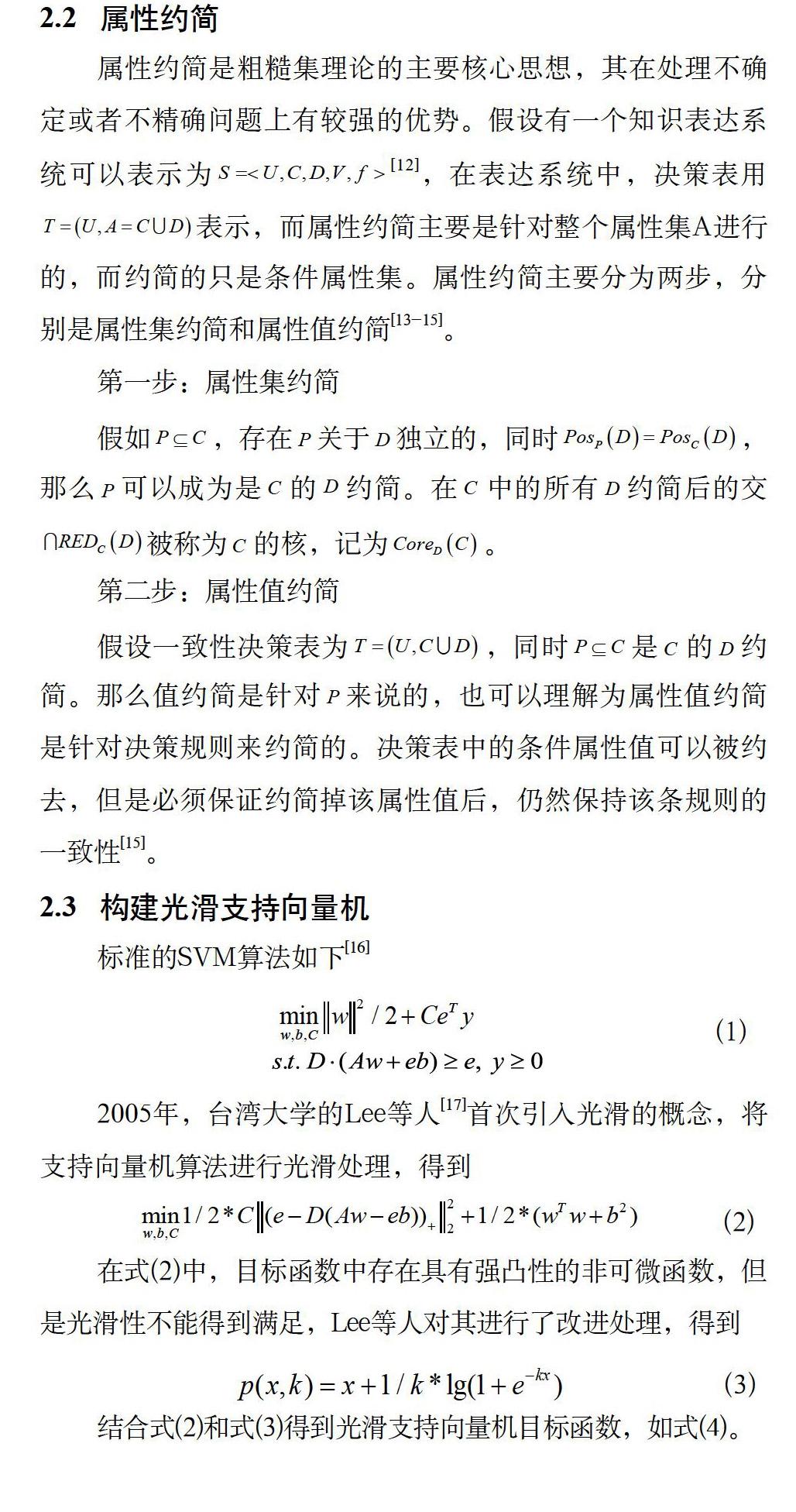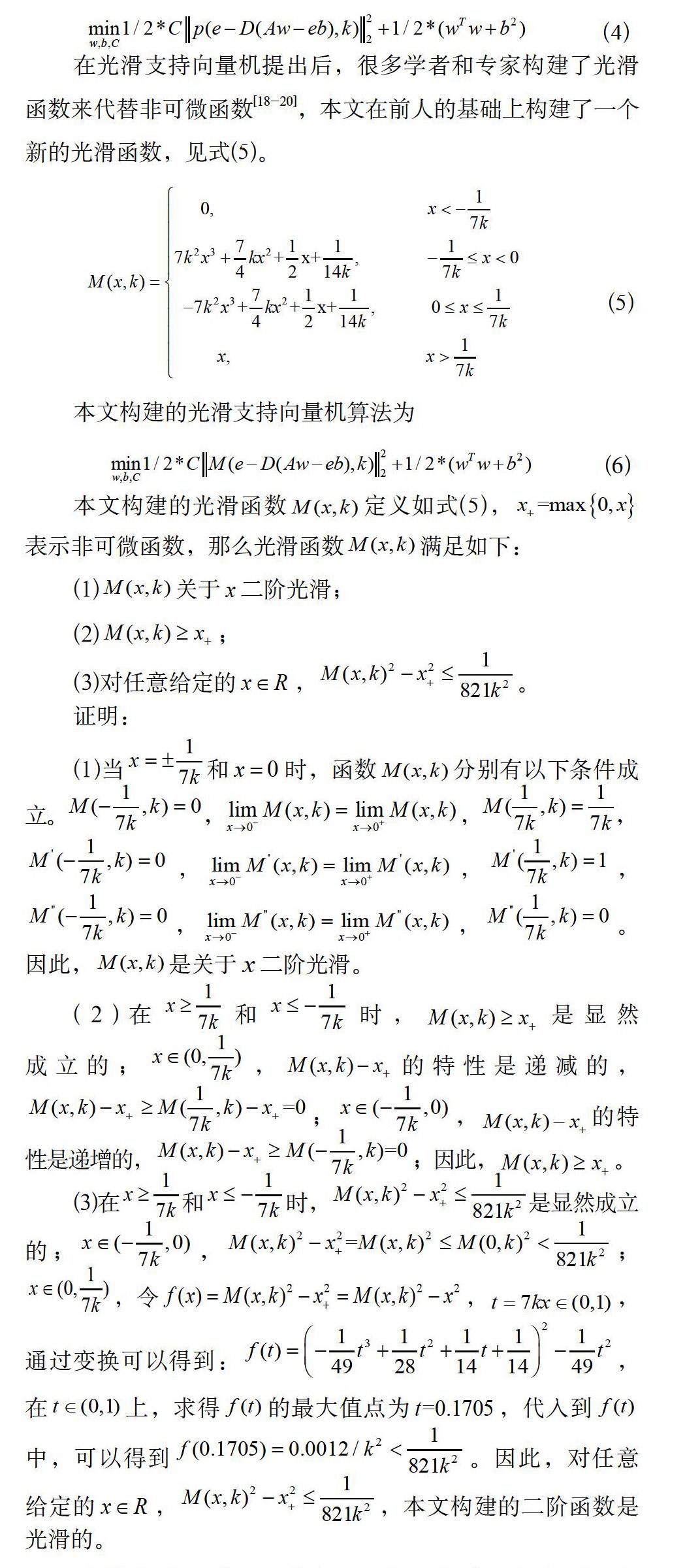基于属性约简—光滑支持向量机的中小企业信息化评价研究
戴强



摘 要:本文以企业信息化的软硬件保障水平、信息化组织水平、信息技术应用与盈利水平、信息化能力水平四个角度建立中小企业信息化评价体系,应用粗集的属性约简理论对指标进行约简,同时构建了一个二阶分段光滑函数支持向量机模型,利用光滑支持向量机对企业的信息化水平进行了评价,最后,通过具体实例进行实证分析,以证明方法的有效性。
关键词:企业信息化;光滑支持向量机;属性约简
中图分类号:TP301 文献标识码:A
Abstract: In this research, the information evaluation system for SMEs is established from the four perspectives of enterprise informationization: software and hardware security level, information organization level, information technology application and profit level, and the informationization level. Through applying the attribute reduction theory of rough set to the index and meanwhile constructing the second-order piecewise smooth function support vector machine model, the informationization level of the enterprises is evaluated with the smooth support vector machine. Finally, the method is proved to be effective through the empirical analysis of the real cases.
Keywords: enterprise informationization; smooth support vector machine; attribute reduction
1 引言(Introduction)
随着大数据、边缘计算、物联网、区块链等技术的快速发展,企业的信息化数据呈几何趋势增长,根据互联网数据中心预测,2020年全球企业信息化的数据量将达到35ZB[1]。2016年大数据产业峰会4月27日到28日举行[2],在工业和信息化部的指导下,中国信息通信研究院和数据中心联盟面向企业和政府部门征集大数据在政府及相关部门应用的优秀技术成果和案例,形成政府大数据应用领域的优秀案例汇编。总之,在大数据时代背景下,中小企业信息化水平影响着中小企业的健康发展,然而企业的信息化建设需要投入大量的前期成本,信息化投入的成本能否给中小企业带来效益还是未知[3],因此对中小企业信息化水平进行有效地评估显得尤为重要。
支持向量机(Support Vector Machine,SVM)是人工智能算法一个较新的研究成果[4-7],其应用的领域越来越广泛,SVM的优点是在处理小样本数据时克服了神经网络的过拟合、易入局部极小的问题[8-10]。然而SVM在数据输入训练时,其分类和预测的光滑性略显不足,同时其不能智能的确定输入的训练数据的冗余性,这样就增加了计算运行的复杂度,而粗糙集的属性约简可以有效地降低输入数据中的噪声[11],降低输入数据的冗余性。因此,构造一个二阶分段光滑函数,增强支持向量机的非凸分类和预测性能,将光滑支持向量机智能算法与粗糙集属性约简联合是互补的,将属性约简后的训练指标数据输入到光滑支持向量机中进行训练学习,然后对测试样本进行预测或评价,这样在消除冗余信息减少光滑支持向量机的学习与预测复杂度的同时,提高了光滑支持向量机的精度。因此,本文应用属性约简—光滑支持向量机算法对中小企业信息化水平评价进行了研究。
2 属性约简—光滑支持向量机模型构建 (Attribute reduction-construction of smooth support vector machine model)
2.1 模型构建描述
本文的属性约简—光滑支持向量机联合评价模型主要是应用在中小企业信息化水平评价上,因此构建模型的基本思路是:第一步应用粗糙集的属性约简剔除光滑支持向量机输入的指标数据进行有效地去噪处理,将约简得到的核心属性指标数据分为训练样本和预测样本送进光滑支持向量机进行学习与预测,进而进行有效地评价。
4 结论 (Conclusion)
本文依据中小企业的信息化指标体系,设计了一种基于属性约简—光滑支持向量機的评价模型,通过实例分析,本文算法对中小企业的信息化评价是客观有效地,与比BP神经网的评价效果相比,本文算法更加准确和简便。因此在信息化飞速发展的背景下,本文的研究方法在理论和实际应用中都具有重要的意义。
参考文献(References)
[1] 马立川,裴庆祺,冷昊,等.大数据安全研究概述[J].无线电通信技术,2015,41(1):01-07.
[2] 数博会组委会.2016中国大数据产业峰会暨中国电子商务创新发展峰会[J].中国信息安全,2016(5):4.
[3] 李国杰,程学旗.大数据研究:未来科技及经济社会发展的重大战略领域—大数据的研究现状与科学思考[J].中国科学院院刊,2012,27(6):647-657.
[4] Saunders C, Stitson M O, Weston J, et al. Support vector machine[J]. 2002, 1(4): 1-28.
[5] Lin K C, Chien H Y. CSO-based feature selection and parameter optimization for support vector machine[C]. Pervasive Computing. DOI:10.1109/JCPC.2009.5420080.
[6] Shalev Shwartz S, Singer Y, Srebro N, et al. Pegasos: primal estimated sub-gradient solver for SVM[J]. Mathematical Programming, 2011, 127(1): 3-30.
[7] Shom Prasad Das, Sudarsan Pa dhy. A novel hybrid model using teaching learning based optimization and a support vector machine for commodity futures index forecasting[J]. International Journal of Machine Learning & Cybernetics, 2018, 9(1): 97-111.
[8] Yang Z, Lin H Y. A protein-protein interaction extractor for biomedical literature using SVM and rich feature sets [J]. Journal of Biomedical Informatics, 2010, 43(1): 88-96.
[9] Biswajeet Pradhan. A comparative study on the predictive ability of the decision tree, support vector machine and neuro fuzzy models in landslide susceptibility mapping using GIS [J]. Computers & Geosciences, 2012, 51(2): 350-365.
[10] Qian H, Mao Y, Xiang W, et al. Recognition of human activities using SVM multiclass classifier[J]. Pattern Recognition Letters, 2010, 31(2): 100-111.
[11] 謝宏,程浩忠,牛东晓,等.基于信息熵的粗糙集连续属性离散化算法[J]. 计算机学报,2005,28(9):1570-1574.
[12] Dun Liu, Tianrui Li, Junbo Zhang. A rough set based incremental approach for learning knowledge in dynamic incomplete information systems[J]. International Journal of Approximate Reasoning, 2014, 55(9): 1764-1786.
[13] Siyuan Jing. A hybrid genetic algorithm for feature subset selection in rough set theory[J]. Soft Computing, 2013, 18(7): 1373-1382.
[14] Richard Jensen, Andrew Tuson. Finding rough and fuzzy rough set reducts with SAT[J]. Information Sciences, 2014, 255: 100-120.
[15] Phophalia A, Rajwade A, Mitra S K. Rough set based image denoising for brain MR images[J]. signal processing, 2014, 103(10): 24-35.
[16] Burges C. A tutorial on support vector machines for pattern recognition[J]. Data Mining and Knowledge Discovery, 1998, 2(2): 121-167.
[17] Lee Y J, Hsieh W F, Huang C M. A smooth support vector machine for epsilon insensitive regression [J]. IEEE Transactions on Knowledge & Data Engineering, 2005, 17(5): 678-685.
[18] 袁玉波,严杰,徐成贤,等.多项式光滑的支撑向量机[J].计算机学报,2005,28(1):9-17.
[19] Wu Q. A new class of piecewise smooth support vector regressions[J]. Journal of Information Science Engineering, 2015, 31(5): 1813-1828.
[20] Qing Wu, Bo Li, Wa Wang, et al. Face recognition method based on multi-class classification of smooth support vector machine[J]. Journal of Computer Applications, 2015, 19(5): 688-696.
[21] 肖素梅,殷国富,汪永超,等.企业信息化水平评价指标与评价方法研究[J]. 计算机集成制造系统,2005(08):106-114.
[22] 何永琴,王燕嘉,毛文静,等.中小企业信息化水平调查研究[J].内蒙古财经大学学报,2015(2):60-67.
[23] 李鹏飞.制造企业信息化水平的评价研究[D].青岛:中国海洋大学,2013.
[24] 李钢,田丽娜,齐二石,等.基于BP神经网络和遗传算法的企业信息化评价研究[J].科技进步与对策,2018,25(5):129-132.
作者简介:
戴 强(1972-),男,本科,工程师.研究领域:人工智能,信息化评估.

